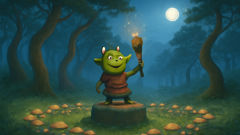Introduction
High above the braided rivers and terraced fields, where the snow keeps its own calendar and prayer flags unspool their colors into the wind, the Himalayas keep stories like nests: hidden, layered, persisted through generations. Among those stories are songs of the Kinnari and Kinnara—celestial beings whose voices bear the clarity of bells and the longing of rivers. Part human in face and gesture, part bird in wing and feather, they live along invisible ridgelines between the world of men and the domain of gods. In Hindu and Buddhist myth, they slip through the temples of stone and the monasteries of wood as both audience and patron, as messengers of longing and keepers of an art older than speech. People in scattered villages have carved their likenesses into lintels and painted them on shrine walls; travelers have whispered their names when the wind lifted and a flute seemed to answer across a valley. Their presence is never merely decorative: they stand as a hinge between earth and sky, song and silence, mortal heart and immortal rhythm. This retelling gathers voices from folk memory and the hush of mountain mornings to explore the Kinnari and Kinnara as lovers and musicians, as teachers of craft and bearers of restraint, and as symbols shaped by devotion, art, and the long histories of pilgrimage that braid south to the plains and east to distant monasteries. The tale that follows is attentive to the music of detail—the rattle of prayer beads, the sheen on a feather, the grain of an old lute—because in these small things the mountains carry an entire world.
Origins and Iconography: Wings Between Worlds
The Kinnari and Kinnara appear at the crossroads of art and belief, where images and stories meet to shape how people see the sacred. Their earliest contours are traceable in both the Hindu and Buddhist imaginal landscapes—half-bird, half-human figures who embody beauty, musical skill, and the generosity of that skill. Scholars and storytellers note parallels with Greco-Buddhist art in some regions, but the Kinnari and Kinnara always arrive with local particularity: draped in silk or bark-cloth depending on the climate of the workshop, wearing anklets or talismans that speak of regional devotion, carrying instruments whose shape changes with craft traditions. In temple carvings across South and Southeast Asia they tilt in mid-flight, a living suggestion of motion carved into immobile stone.

The iconography matters because it is language. In Buddhist art, the Kinnara and Kinnari often populate the periphery of stories about enlightenment. They are attendants at celestial palaces, entertainers in paradisiacal courts, and sometimes lovers separated by vows or by fate who teach compassion through their yearning. In Hindu stories, they may be encounters on the edges of epics—brief but bright—where a hero hears a voice that changes the course of a journey. Their instruments—lutes like the vina, flutes like the bansuri, drums or small cymbals—name the forms of devotion they can offer. Musicianship becomes prayer when it is played without attachment.
To speak of their name etymologically is to enter a field of subtle shifts. Kinnara can be masculine and plural; Kinnari, the graceful feminine. When poets have time, they make language a mirror: the Kinnari’s songs paint the world in softer lines; the Kinnara’s rhythms set a traveler’s heartbeat to compass. Their feathers range in color with region and storyteller—pearled white in one valley, a deep iridescent blue in another, mottled browns when the artist intends humility. Even when their wings are folded in relief, one feels the promise of lift.
Folk ritual has kept them close. In certain Himalayan villages they appear on house lintels as guardians of threshold sound: a carved Kinnara flanking a doorway will be tuned to receive the first sound of the day—a cowbell, a child’s laugh, the scrape of a mortar—because daily life itself must be blessed by song. Monks in regional monasteries recite verses that reference them in long cyclical rituals; women who winnow rice will hum Kinnari melodies to steady their hands. The sense is everywhere that music—especially music that is compassionate and unselfed—has moral weight. It restores balance. It softens grief.
Beyond stone and song, story collections and local tellings create entire genealogies. In one oral tradition, Kinnara are the lineage keepers of melodies that cannot be written down; they pass song from wing to wing as if it were a living heirloom. When a human is taught by a Kinnari, the transmission is not merely technique; it is an initiation into a way of listening. The pupil learns not only the cadence but the silence that gives the cadence meaning. To be taught by a Kinnari is to be bound, briefly, to the mountain’s own timing. In other tales the Kinnara are messengers between lovers: a song taking the place of a letter, a whistle becoming a vow. The Himalayan high passes, cold and solitary, are natural stages for such exchanges: sound travels strangely there—sharp, enduring, surprised into clarity by ice.
These stories do not present a single doctrine. Rather they form a braided archive. Each village retells them with local inflection; each monastery enshrines a piece of their repertoire. Some accounts paint them as purely celestial, untouched by human sorrow. Others allow them a tender vulnerability—a Kinnari longing for a human child, a Kinnara giving up flight out of compassion. The ability to shift between divine aloofness and intimate tenderness allows the Kinnari and Kinnara to stand as mirrors for the living: they are the beauty we aspire to and the compromise we must learn when compassion meets the world’s demands.
Their voices are described by witnesses as crystalline, as if the sound had been filtered by ice and bell-metal. Travelers' diaries from colonial times sometimes record hearing music on a clear night and attributing it to Kinnara. For monks and poets, those accounts were not merely curiosities but prompts: they suggested a natural theology in which music itself was a bridge. Birds and humans, gods and men—these distinctions blur when the mountain wind carries a lullaby from one ridge to another. Listening becomes the primary spiritual exercise, a practice of opening the self like an instrument. The Kinnari and Kinnara exist at the heart of that practice, reminding listeners that every melody has an ethical shape—softening anger, sharpening compassion, coaxing the lost toward path and name.
In the visual arts, the Kinnari and Kinnara often appear mid-motion: a foot about to lift, a head curved toward a distant star, a wing caught in a gesture that might be either blessing or farewell. That equivocation is their central charm. They can bless a newborn and mourn a dying star. The duality—of bird and human, of artistry and devotion—makes them useful figures for storytellers seeking to teach without lecturing. They show pathos through posture and meaning through music. Their myths, then, are not static; they remain alive in the mouths and hands of those who keep singing.
When modern artists reinterpret them, they often emphasize interchange: the Kinnari teaching a girl to shape breath into melody, a Kinnara listening to a monk’s recitation and returning it in song. These exchanges are not merely aesthetic. They represent a continuing belief that art binds communities across time. The Kinnari and Kinnara, as embodiments of that belief, remain vital because they are always available for retelling—placed into new scenes, lending old genius to young hands.
Across the valleys and monasteries, carved or painted, sung in lullabies or recited in long rituals, the Kinnari and Kinnara remain, in essence, teachers of attention. Their wings point to the heavens; their faces look toward the earth. Between the two, their music occupies a narrow path that every pilgrim recognizes: a path to beauty that asks for nothing but the listener’s presence.
Stories from the Ridge: Lovers, Musicians, and Lessons
Stories of the Kinnari and Kinnara blossom where travel is slow and memory is long. There is a tale told in the lower valleys of a musician named Amar, who had the patience of a slow river and the hunger of a new traveler. One winter, compelled by a grief he could not name, he made the climb to a pass where the villagers said the sky leaned close to the earth. The path was an old one, flung with scree and prayer stones. On the third night, with his breath clouding the lantern light, he heard a melody not of this plain: a tune that threaded through his ribs and came out the other side as a thought. Waiting by a cairn, he saw her—Kinnari, feathers glossy as pond-shadow, hands pressed to a lute like a bridge. Her song asked the empty air for company; Amar answered with a simple motif he had learned from his mother. The two pieces braided until dawn broke like an opened shell.

The Kinnari listened and then, with a tilt that acknowledged both curiosity and caution, offered him a bargain: if he would learn not only to play but to silence his music when asked, she would teach him a melody that soothed fever and soothed grief. Amar agreed—he did not know the cost of silence—and fell under the Kinnari’s patient training. The first lesson was to listen to the rhythm of the snow. The second was to play to the spaces between notes. The third asked for a small sacrifice: his pride, measured by a silver ring his father had given him. He let the ring slip into the crevasse beneath a prayer flag, and the mountain accepted it with a breath.
When a festival came to the valley months later, Amar used the melody and the disciplined restraint the Kinnari had taught him. He played at the bedside of a woman shrouded in fever; the notes shone like balm, and the fever broke. News of the miracle spread—not because Amar sought praise, but because the melody belonged to a lineage that had learned from wings. He never saw the Kinnari again in that life, though sometimes, on windless nights, his lute would pick up a thread of a melody he could not place, and he would smile as if at the memory of a teacher's hand.
Another tale, older and quieter, speaks of a Kinnara who fell in love with a temple dancer. He did not seek to make himself human; he admired her the way one admires a flame. He performed outside the temple at dusk, placing his songs as offerings beneath the dancer’s feet. She, in return, left a single jasmine braid on the threshold—an acknowledgment and a gentle refusal. Their exchange was respectful and ritualized, shaped by vows and boundaries. But there is a sorrow in stories like this that is not tragedy so much as a lesson: yearning may be pure, but not all yearning will be transformed into union. Sometimes longing educates rather than consummates.
The Kinnari and Kinnara also appear in tales of moral teaching. In one widely told parable there was a greedy merchant who decided to trap a Kinnara to profit from his song. He dug a pit and laid out instruments as bait. When the Kinnara arrived, he sang of mountains and of the sky as if neither owed him anything. The merchant, blinded by desire for wealth, leapt and missed the music’s true bearing; he fell into his own pit and found no comfort among the instruments. The moral is simple and old: music cannot be owned. Attempting to possess art is like trying to cage the wind. The villagers would teach this story to children to remind them that generosity is the natural habitat of song.
Across stories, the mountain itself is a character—temperamental, generous, indifferent. The Kinnari and Kinnara know how to read its moods. They take shelter in caves lined with Buddha images during storms and emerge at dawn to trade songs with shepherds. Often they appear as teachers of craft, giving a village exact instructions about how to angle a bell or how to tune a drum so it will be heard beyond a valley. They will return a lost lamb through a song that calls it home. They are not exclusively benevolent; they can be stern, withholding songs from those who would use music for cruelty. That strictness holds a moral logic: art should not worsen the world.
In one long narrative preserved by a monastic chronicle, a young novice named Sera is taught by a Kinnari as part of a test in compassion. The abbess of the monastery feared Sera’s impatience, so she sent him to the pass with strict instructions: return only after learning a song that will calm a grieving mother. Sera found the Kinnari, who agreed to teach him only if he would string beads of different sounds into a single rosary of melody. He learned the learning of humility: how to listen when someone sobs, how to let silence be a brace for the sound, how not to hurry the heart that needs time. When he returned, the song did not immediately cure the mother; it gave her room to cry and, in that room, a path to peace. The abbess praised the lesson not because of the miracle but because Sera returned changed: steadier, softer in his speech.
Perhaps the most famous love story involves a Kinnari who fell in love with a wandering prince. The prince, noble by blood and restless by temperament, met her at a lake whose surface was kept mirror-clear by prayers. She taught him a melody that could still a river’s motion. For months they shared music and stories. But when duty called the prince to a distant kingdom, he asked the Kinnari to follow. She refused, not out of cruelty but out of fidelity to the laws of her kind: she could not live tethered wholly to a human life. The prince left, gifted with songs that would later become courtly measures for peace. The prince married and ruled well, and when his grandchildren sang those notes centuries later, the kingdom kept a memory of the mountains alive. The Kinnari, for her part, stayed among the clouded passes and watched tiny human histories unfold like paper lanterns below. Her songs remained a quiet, available consolation, one a traveler might encounter in loss or love.
These narratives converge on common lessons: music is sacred, generosity is necessary, and restraint can be a form of devotion. The Kinnari and Kinnara embody qualities that cultures want to hold up—art as service, beauty as ethical practice. They are not perfect beings dispatched to fix human flaws; they are models that offer alternatives. Sometimes their interventions are miraculous; more often, they teach humans rhythms and silences that allow ordinary life to become bearable.
Contemporary retellings give them new frames. A poet in a city may write about a Kinnari perched on the edge of a traffic flyover, singing at dawn for ragpickers. An animator might place a Kinnara in a glassy metropole, his wings catching neon. These updates reflect a living tradition—myth adapting to urban ears—without erasing what was essential: the insistence that beauty belongs to all who listen. The Kinnari and Kinnara persist as reminders that even in hurried modernity, a moment can be taken to tune one’s heart to a purer pitch. That is the smallest, truest grace their stories give.
Conclusion
The myth of the Kinnari and Kinnara offers more than spectacle; it offers a way of living attuned to beauty and to the responsibilities of art. Their half-bird bodies point upward while their human faces look toward the ordinary world, reminding us that neither heaven nor earth is sufficient alone. Across temples and village walls, in lullabies and long monastic chants, their music continues to teach attention, patience, and restraint. When a traveler hears a flute at the pass, or a child hums a tune that seems older than family memory, the Kinnari and Kinnara are present—less as distant gods and more as persistent invitations. They ask only that we listen with care, that we shape sound into service, and that we keep, in the swiftly changing world, a space where song may still do the work of softening sorrow and binding community. Their legends remain useful because they are generous: they give melody freely and, in return, ask that we return what we can—a small act of kindness, a quiet performance, a life lived with an ear attuned to the world’s hidden harmonies.













